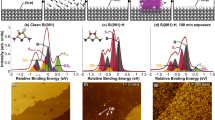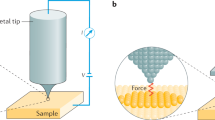Abstract
THE potential of the scanning tunnelling microscope (STM) as a tool for the high-resolution manipulation of surfaces and surface-adsorbed phases has been amply demonstrated1–5. In general, previous studies have been concerned with the physical rearrangement of surface atoms and molecules. Here I report the use of the STM to achieve chemical modification of a surface. An STM is used to etch the surface of a mixed-ionic conductor (AgxSe), producing selected patterns of grooves about 10 nm wide. The etching process seems to involve the segregation of different chemical species on the surface: silver atoms migrate into the semiconductor matrix that underlies the AgxSe film, exposing selenium ions which are then removed from the surface by reaction with ambient hydrogen. Chemical modification of this sort may come to play a part in future nanometre-scale technologies.
This is a preview of subscription content, access via your institution
Access options
Subscribe to this journal
Receive 51 print issues and online access
$199.00 per year
only $3.90 per issue
Buy this article
- Purchase on Springer Link
- Instant access to full article PDF
Prices may be subject to local taxes which are calculated during checkout
Similar content being viewed by others
References
Eigler, D. M. & Schweizer, E. K. Nature 344, 524–526 (1990).
Foster, J. S., Frommer, J. E. & Arnett, P. C. Nature 331, 324–326 (1988).
Arbrecht, T. R. et al. Appl. Phys. Lett. 55, 1727–1729 (1989).
Li, Y. Z., Vazquez, L., Piper, R., Andres, R. P. & Reifenberger, R. Appl. Phys. Lett. 54, 1424–1426 (1989).
Garfunkel, E. et al. Science 246, 99–100 (1989).
Miyatani, S. J. phys. Soc. Japan 14, 996–1002 (1959).
Phillips, J. C. J. non-Crystalline Sol. 64, 81–85 (1984).
Craston, D. H., Lin, C. W. & Bard, A. J. J. electrochem. Soc. 135, 785–786 (1988).
Wagner, C. J. Metals 4, 214–216 (1952).
Kobayashi, H. & Wagner, C. J. chem. Phys. 26, 1609–1614 (1957).
Utsugi, Y., Kakuchi, M. & Maezawa, H. Rev. sci. Instrum. 60, 2295–2298 (1989).
Utsugi, Y., Yoshikawa, A. & Kitayama, T. Microelectron. Engng 2, 281–298 (1984).
Author information
Authors and Affiliations
Rights and permissions
About this article
Cite this article
Utsugi, Y. Nanometre-scale chemical modification using a scanning tunnelling microscope. Nature 347, 747–749 (1990). https://doi.org/10.1038/347747a0
Received:
Accepted:
Issue Date:
DOI: https://doi.org/10.1038/347747a0
This article is cited by
Comments
By submitting a comment you agree to abide by our Terms and Community Guidelines. If you find something abusive or that does not comply with our terms or guidelines please flag it as inappropriate.



